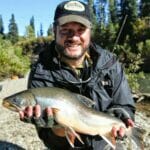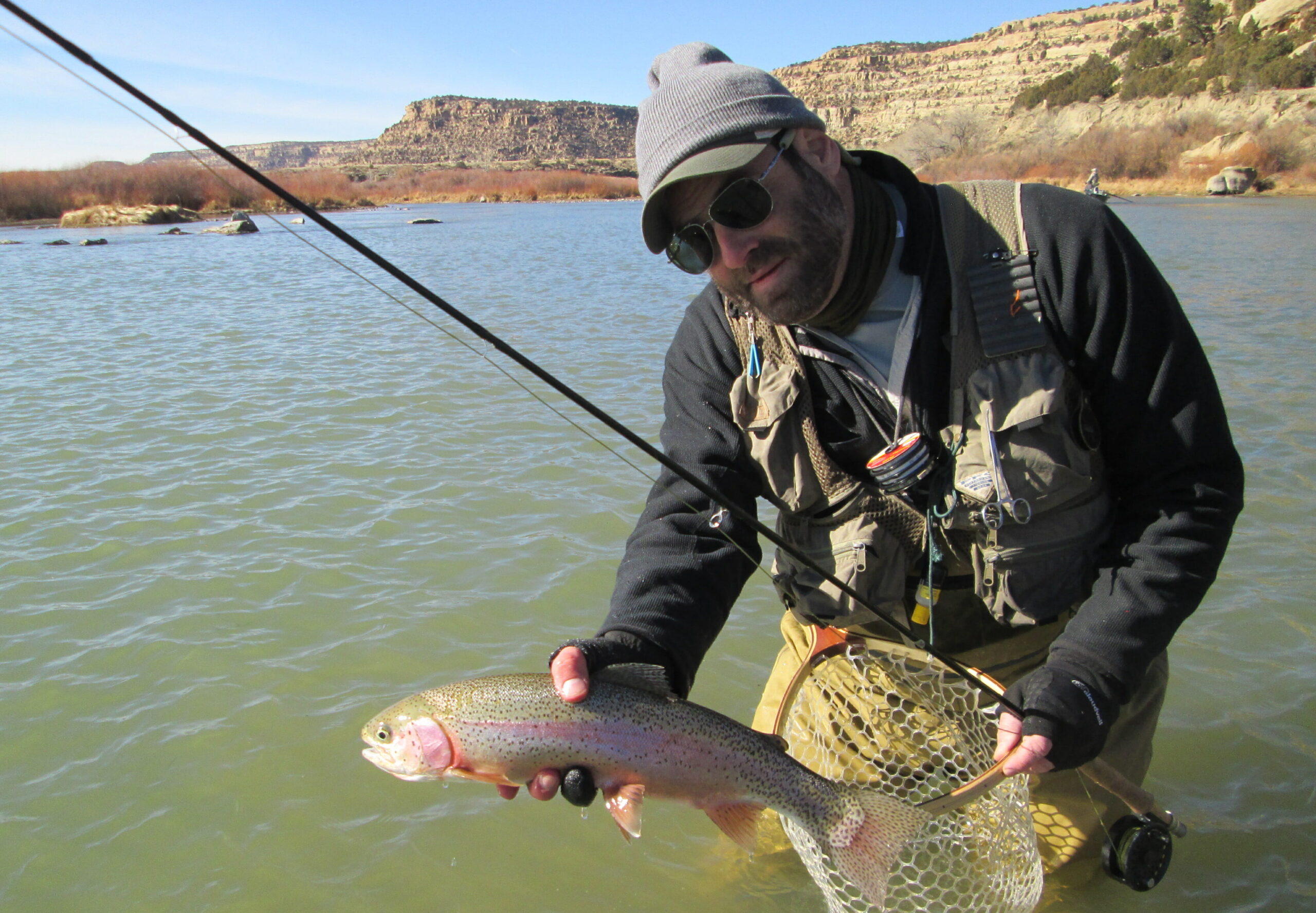A recent proposal to do away with regulations on the San Juan could have impacted the fishery and the experience for anglers. Thankfully, the proposal to drop the regulations was rescinded. Trout Unlimited photo.
By Toner Mitchell
A rumor recently surfaced that the New Mexico Game and Fish Department was planning to eliminate two heavily supported regulations on the San Juan River. One was the decades-old prohibition of the “San Juan Shuffle”, the practice of shuffling one’s feet on the stream bottom and fishing downstream to the growing pod of fish drawn from distances as great as 50 feet to the resulting food cloud. The second regulation change was the elimination of the maximum limit on flies an angler could fish at once, currently set at two.
Concerned anglers and guides wondered if the state wanted to improve upon the San Juan’s already stratospheric catch rate, or if it simply sought to bring San Juan regulations in line with the rest of the state’s fisheries. As of today, these speculations are moot. Perhaps anticipating the public outcry that would erupt from the proposed changes, the Department decided to rescind them.

Anglers fish the San Juan River below Navajo Dam. Trout Unlimited photo.
Bullet dodged, but conversation started.
Like other big waters like the Bighorn, Green, Madison, Frying Pan, and Kenai, the San Juan is enjoyed by a ton of anglers on any given day. Unlike these fisheries, however, the San Juan offers far less water (normal flow is 350-cfs over 4.25 miles) and is fishable – though periods of snow and extreme cold do occur – every single day of the year. In terms of space per angler, if the San Juan sometimes feels more crowded than other streams, it’s because it often is.
Yet the San Juan continues to provide some of the most exciting angling in the United States. The water is cold, the food base seemingly infinite, and the scenery perfectly complements the stunning beauty of the river’s fat trout. The famously robust trout population – tens of thousands of wild browns and naturalized rainbows per mile – is but one component of the San Juan’s excellence. New Mexico Game and Fish has built new habitat to accommodate reduced dam releases and, in effect if not intent, to concentrate crowd-tolerant anglers in some areas while depopulating other areas for anglers preferring more elbow room.
In its essence, the 4.25-mile section of the San Juan below Navajo Dam is a high-quality fishing spot where anglers catch lots of fish and lots of big fish, and it is managed as such. Given this truth, and in the context of catch and release regulations, does it really matter if an angler catches 10 more fish a day because he or she chums the water and runs a trotline of flies?
The data say yes. According to Marc Wethington, San Juan fisheries biologist with the New Mexico Game and Fish, the San Juan absorbs approximately 300,000 angler hours per year and a landed fish rate of one fish per hour, meaning that each fish probably gets landed several times per year (hooked and fought several times more). Age class surveys show San Juan trout rarely survive past five years. Predators take their toll, but Wethington’s professional conclusion is the vast bulk of fish mortality is angler-induced.

The San Juan River in New Mexico is a blue ribbon fishery for good reason. Trout Unlimited photo.
So you shuffle up some bait and drop three flies (I know guys who think nothing of rigging a five-fly daisy chain) into your self-made gaggle of bulky fish. How many more fish do you land? Break off? Snag? What about the guy over there doing the same thing? What about yesterday? Tomorrow? Where’s the tipping point to the fishing going down the toilet? Because there sure as heck will come a tipping point.
Economics matter as well. The San Juan fishery generates an estimated 35 million dollars each year in economic activity in an area heavily dependent on the energy industry. During bust cycles, the job diversity fueled by angling nurses the region – including two small cities, huge swaths of four states, and two large tribal reservations – towards better days. Recreation in this sparsely populated area employs people across age groups, skill sets, and education levels.
Like Fort Smith, Montana, Cooper Landing, Alaska, or Dutch John, Utah, Navajo Dam, New Mexico, would be a ghost town without the fishing. As it is, the economy driven by the San Juan River also pumps license revenue to Game and Fish, which must fund the management of not only the San Juan, but countless other wildlife assets throughout New Mexico. Thus, the San Juan essentially pays rent for resources that generate a fraction of the visitation and revenue.
Finally, leaving aside the ethical ridiculousness of enabling chumming and trotlines at a catch and release fishery, it is necessary to protect wise regulations because conservation says so. I’ve heard all the talk about crowded fisheries, from folks who knew XYZ river before the word got out, before the crowds made it into the zoo it is today, and who cares about it anymore? Heck, I thought such things myself before learning more about how resources should interweave and work. And by work, I mean like a mule. Again, resources like the San Juan pay the rent. They do it 24/7, year round, generating dollars for local and national companies, state and local tax coffers, while delivering numerous other benefits that arise from quality fishing and then sustain it.
No matter what we think of (arguably) over-popular resources like the San Juan River, we must remember all they’ve done to warrant our conservation interest. How many first fish have been caught there, how many angling, guide, or conservationist careers born? How many memberships to conservation groups like Trout Unlimited resulted from a great day on the Juan? Indeed, how many TU chapters or counsels have benefitted from generous donations from San Juan guides and lodges?
Especially in this age of exploding population and need for recreation, we must remind ourselves that conservation does not take days off. We don’t rear our favorite places to some arbitrary point when they can be kicked from the nest. No, the love we give our rivers is a forever deal, because of what they are, but increasingly because they have earned it.
Toner Mitchell is the New Mexico Water and Habitat Coordinator for Trout Unlimited. He is based out of Santa Fe.



